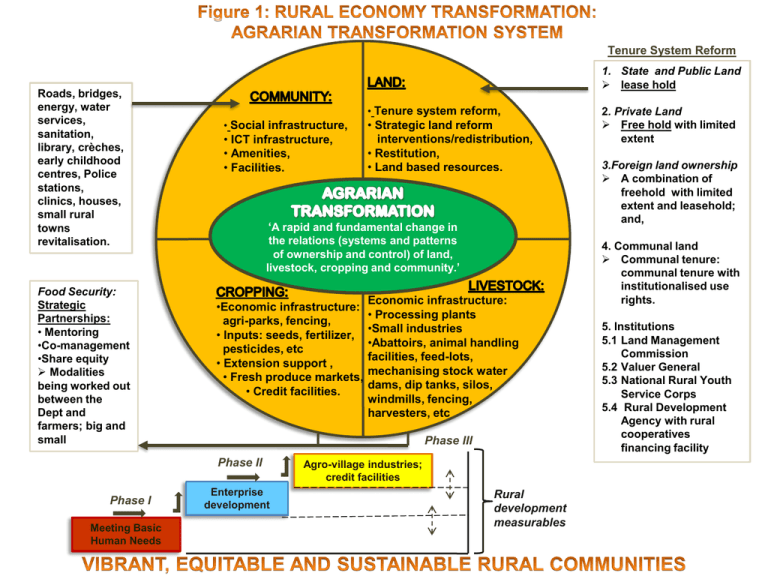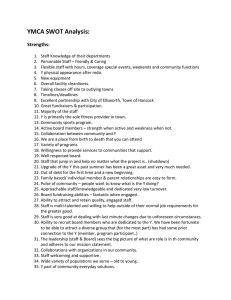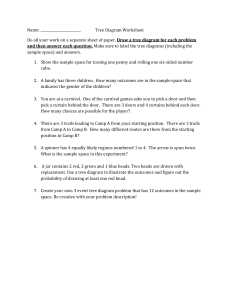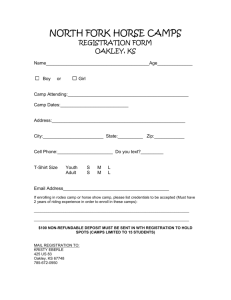Figure 1: RURAL ECONOMY TRANSFORMATION
advertisement

Tenure System Reform Roads, bridges, energy, water services, sanitation, library, crèches, early childhood centres, Police stations, clinics, houses, small rural towns revitalisation. Food Security: Strategic Partnerships: • Mentoring •Co-management •Share equity Modalities being worked out between the Dept and farmers; big and small 1. State and Public Land lease hold • Tenure system reform, • Social infrastructure, • ICT infrastructure, • Amenities, • Facilities. ‘A rapid and fundamental change in the relations (systems and patterns of ownership and control) of land, livestock, cropping and community.’ •Economic infrastructure: agri-parks, fencing, • Inputs: seeds, fertilizer, pesticides, etc • Extension support , • Fresh produce markets, • Credit facilities. Meeting Basic Human Needs Economic infrastructure: • Processing plants •Small industries •Abattoirs, animal handling facilities, feed-lots, mechanising stock water dams, dip tanks, silos, windmills, fencing, harvesters, etc Phase III Phase II Phase I • Strategic land reform interventions/redistribution, • Restitution, • Land based resources. Enterprise development Agro-village industries; credit facilities Rural development measurables 2. Private Land Free hold with limited extent 3.Foreign land ownership A combination of freehold with limited extent and leasehold; and, 4. Communal land Communal tenure: communal tenure with institutionalised use rights. 5. Institutions 5.1 Land Management Commission 5.2 Valuer General 5.3 National Rural Youth Service Corps 5.4 Rural Development Agency with rural cooperatives financing facility Outer Boundary: Single Title Title Holder: Governance Structure. Roles: • Title Holder • Adjudication of disputes on land allocation and use • Reference Point •Land allocation TRADITIONAL MANAGEMENT COMMUNITYPUBLIC-PRIVATECOLLABORATION COMMUNALLY OWNED: * * * 1 * * * * * *** * * * * * * * * * * * * 7 6 2 •Residential •Economic •Social Services 5 3 4 COMMUNALLY OWNED: Collective and individual enterprise and industrial sector 1–7 HOUSEHOLD SECTOR: Basic unit of production 2 Outer Boundary: Single Title Title Holder: Governance Structure. COMMUNALLY OWNED: Roles: • Title Holder • Adjudication of disputes on land allocation and use • Reference Point •Land allocation 1 8 COMMUNITYPUBLIC-PRIVATECOLLABORATION 7 2 3 •Residential •Economic •Social Services 6 4 5 COMMUNALLY OWNED: Collective and individual enterprise and industrial sector 1–8 HOUSEHOLD SECTOR: Basic unit of production 3 As set out in the Constitution and the law of the Republic AUTHORITY: THE STATE ADMIN. RESPONSIBILITY: GOVERNANCE STRUCTURE INVESTMENT AND DEVELOPMENT FINANCING FACILITY 1 INSTITUTIONALISED USE RIGHTS: • Perpetuate the right in law •Can will the right •Can use as collateral •Protection against land sharks - first right of refusal: RIDFF - Second right of refusal: Govt 2 3 Rights and Responsibilities 4 Duties and Services 5 6 7 Opportunities and Constraints Active Citizenry and Capable State: The National Development Plan Traditional Council/ CPA Committee/ Trust, as the case may be. Key elements of accountability: •Substantive, NOT numerical quorum • Quarterly meetings • Annual reports to Parliament via drdlr •Regular elections, as defined by the law IDT: Representative of Households, Traditional Council, Municipal Council, Local Business, Civic Structures HOUSEHOLDS: •Basic Unit of Production •Consumers of Goods and Services •Rate Payers •Voters CLUSTER OF VILLAGES Camp1 Camp 2 Camp 3 PROJECTS: • Soil Rehabilitation Trees • Re-greening the environment Fruit trees Vegetables Grass Camp 4 Camp 5 Camp 6 • Decongesting the 13% space by relocating livestock owners to 87% space. Gabion Camp 7 Camp 8 Camp 9 • Rekindling the class of black commercial farmers destroyed by the 1913 Natives Land Act CHANGE AGENTS: • NARYSEC • EPWP • CWP






